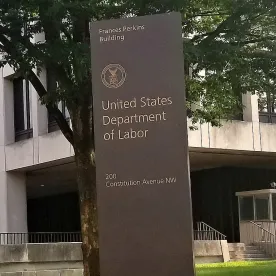In its first installment of opinions letters in 2020, the U.S. Department of Labor’s Wage and Hour Division (“WHD”) addressed two issues under the Fair Labor Standards Act (“FLSA”): (i) the salary basis requirements in the context of per-project compensation arrangements and (ii) calculation of overtime pay for employees who receive nondiscretionary lump-sum bonus payments earned over time and not tied to a specific period. (A third letter, FMLA2020-1-A, considered FMLA requirements vis-à-vis public employees.) While neither of these FLSA opinion letters addresses controversial or novel issues, they offer useful guidance to employers facing similar scenarios and helpfully reiterate general principles of broad applicability.
The Salary Basis Requirements
As background, in order for an employee to qualify for the white-collar exemptions, he or she must satisfy the duties test and be paid “on a salary or fee basis.” 29 C.F.R. §§ 541.200(a)(1), -.300(a)(1). An employee paid on a salary basis receives a predetermined amount each pay period that meets the minimum salary threshold and is not subject to reduction based on the employee’s performance. 29 C.F.R. § 541.602. In contrast, an employee paid on a fee basis receives “an agreed sum for a single job regardless of the time required for its completion[,]” and that job must be “unique.” 29 C.F.R. § 541.605(a).
In FLSA2020-2, the WHD analyzed whether two per-project compensation arrangements met the salary basis requirements. Under the first arrangement, an educational consultant tasked with developing a curriculum for teaching literacy for its school district client received $80,000 in 20 biweekly installments, regardless of the number of hours worked in any specific week, for working up to 80 hours per week for a 40-week period. Under the second arrangement, the same educational consultant received an additional $6,000 in four $1,500 biweekly payments for designing and conducting five teacher workshops over an eight-week period, with payment subject to increases depending on variations in the number of additional projects assigned. The WHD found that the first arrangement satisfies the salary basis requirement, and the second arrangement satisfies the salary basis requirement as “extra” compensation pursuant to 29 C.F.R. § 541.604(a). Regarding the latter, the WHD advised that an employer can provide an exempt employee extra compensation on any basis for hours worked beyond the normal work week—here, beyond the scope of the first project.
Importantly, the WHD cautioned that while employers and employees can change the scope of a project, thereby increasing or decreasing the employee’s bi-weekly payment, frequent revisions of this nature resulting in consistently varying biweekly compensation may indicate that the amount of the payment is, in fact, actually based on the quantity or quality of the work performed, in contravention of the salary basis requirements.
Nondiscretionary Lump-Sum Bonuses
In FLSA2020-1, an employer solicited guidance from the WHD on how to calculate overtime payments for employees who are eligible to receive a lump-sum bonus of $3,000 if they successfully complete ten weeks of training and agree to continue to train for an additional eight weeks, even if they ultimately complete only one of the additional eight weeks of training.
As an initial matter, the WHD advised that the employer must include the lump-sum bonus in the employees’ regular rate of pay because it is an inducement for employees to complete the ten-week training and must allocate the bonus to the initial ten-week training period because the additional training is not required to retain the bonus. 29 C.F.R. § 778.211(c). For bonuses that cover more than one pay period, the regulations describe two ways to allocate bonuses: (i) dividing the bonus amount by the total number of workweeks in the period or (ii) dividing the bonus by the hours worked in the time period covered by the bonus (which can result in allocating various amounts of bonus money across the different workweeks). 29 C.F.R. § 778.209(b). The WHD preferred the former method here because “there are no facts provided which would make it inappropriate to assume equal bonus earnings per workweek.” Finally, the employer must calculate the additional overtime pay due in those workweeks of the ten-week training period in which the employee worked more than 40 hours. 29 C.F.R. § 778.209(b).




 />i
/>i
